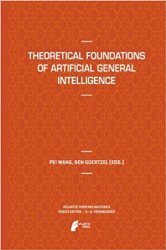
Автор: Pei Wang, Ben Goertzel
Название: Theoretical Foundations of Artificial General Intelligence
Издательство: Atlantis Press
Год: 2016
ISBN: 9789491216619
Серия: Atlantis Thinking Machines (Book 4)
Язык: English
Формат: pdf
Размер: 10,6 mb
Страниц: 334
Each chapter focuses on one theoretical problem, proposes a novel solution, and is written in sufficiently non-technical language to be understandable by advanced undergraduates or scientists in allied fields.
This book is the very first collection in the field of Artificial General Intelligence (AGI) focusing on theoretical, conceptual, and philosophical issues in the creation of thinking machines. All the authors are researchers actively developing AGI projects, thus distinguishing the book from much of the theoretical cognitive science and AI literature, which is generally quite divorced from practical AGI system building issues. And the discussions are presented in a way that makes the problems and proposed solutions understandable to a wide readership of non-specialists, providing a distinction from the journal and conference-proceedings literature. The book will benefit AGI researchers and students by giving them a solid orientation in the conceptual foundations of the field (which is not currently available anywhere); and it would benefit researchers in allied fields by giving them a high-level view of the current state of thinking in the AGI field. Furthermore, by addressing key topics in the field in a coherent way, the collection as a whole may play an important role in guiding future research in both theoretical and practical AGI, and in linking AGI research with work in allied disciplines
1. Introduction
Pei Wang and Ben Goertzel
1.1 The Matter of Artificial General Intelligence
1.2 The Matter of Theoretical Foundation
1.3 The Matter of Objective
1.4 The Matter of Approach
1.5 Challenges at the Heart of the Matter
1.6 Summary
Bibliography
2. Artificial Intelligence and Cognitive Modeling Have the Same Problem
Nicholas L Cassirnatis
2.1 The Intelligence Problem
2.2 Existing Methods and Standards are not Sufficient
2.3 Cognitive Modeling: The Model Fit Imperative
2.4 Artificial Intelligence and Cognitive Modeling Can Help Each Other
2.5 Conclusions
Bibliography
3. The Piaget-MacGuyver Room
Selmer Bringsjord and John Licato
3.1 Introduction
3.2 More on Psychometric AGI
3.3 Descartes’Two Tests
3.4 Piaget’s View of Thinking & The Magnet Test
3.5 The LISA model
3.6 Analogico-Deductive Reasoning in the Magnet Test
3.7 Next Steps
Bibliography
4. Beyond the Octopus: From General Intelligence toward a Human-like Mind
Sam S. Adams and Steve Burbeck
4.1 Introduction
4.2 Octopus Intelligence
4.3 A “Ladder” of Intelligence
4.4 Linguistic Grounding
4.5 Implications of the Ladder for AGI
4.6 Conclusion
Bibliography
5. One Decade of Universal Artificial Intelligence
Marcus Hutter
5.1 Introduction
5.2 The AGI Problem
5.3 Universal Artificial Intelligence
5.4 Facets of Intelligence
5.5 Social Questions
5.6 State of the Art
5.7 Discussion
Bibliography
6. Deep Reinforcement Learning as Foundation for Artificial General Intelligence
Itamar Arel
6.1 Introduction: Decomposing the AGI Problem
6.2 Deep Learning Architectures
6.3 Scaling Decision Making under Uncertainty
6.4 Neuromorphic Devices Scaling AGI
6.5 Conclusions and Outlook
Bibliography
7. The LIDA Model as a Foundational Architecture for AGI
Usef Faghihi and Stan Franklin
7.1 Introduction
7.2 Why the LIDA Model May Be Suitable for AGI
7.3 LIDA Architecture
7.4 Cognitive Architectures, Features and the LIDA Model
7.5 Discussion, Conclusions
Bibliography
8. The Architecture of Human-Like General Intelligence
Ben Goertzel, M. Ikle, and J. Wigmore
8.1 Introduction
8.2 Key Ingredients of the Integrative Human-Like Cognitive Architecture
8.3 An Architecture Diagram for Human-Like General Intelligence
8.4 Interpretation and Application of the Integrative Diagram
8.5 Cognitive Synergy
8.6 Why Is It So Hard to Measure Partial Progress Toward Human-Level AGI?
8.7 Conclusion
Bibliography
9. A New Constructivist AI
Kristinn R. Thorisson
9.1 Introduction
9.2 The Nature of (General) Intelligence
9.3 Constructionist AI: A Critical Look
9.4 The Call for a New Methodology
9.5 Towards a New Constructivist AI
9.6 Conclusions
Bibliography
10. Towards an Actual Godel Machine Implementation
Bas R. Steunebrink and Jurgen Schmidhuber
10.1 Introduction
10.2 The Godel Machine Concept
10.3 The Theoretical Foundations of Self-Reflective Systems
10.4 Nested Meta-Circular Evaluators
10.5 A Functional Self-Reflective System
10.6 Discussion
Appendix: Details of Notation Used
Bibliography
11. Artificial General Intelligence Begins with Recognition
Tsvi Achler
11.1 Introduction
11.2 Evaluating Flexibility
11.3 Evaluation of Flexibility
11.4 Summary
Bibliography
12. Theory Blending as a Framework for Creativity in Systems for General Intelligence
Maricarmen Martinez et al.
12.1 Introduction
12.2 Productivity and Cognitive Mechanisms
12.3 Cross-Domain Reasoning
12.4 Basic Foundations of Theory Blending
12.5 The Complex Plane: A Challenging Historical Example
12.6 Outlook for Next Generation General Intelligent Systems
12.7 Conclusions
Bibliography
13. Modeling Emotion and Affect
Joscha Bach
13.1 Introduction
13.2 Emotion and Affect
13.3 Affective States Emerging from Cognitive Modulation
13.4 Higher-Level Emotions Emerging from Directing Valenced Affects
13.5 Generating Relevance: the Motivational System
13.6 Motive Selection
13.7 Putting it All Together
Bibliography
14. AG I and Machine Consciousness
Antonio Chella and Riccardo Manzotti
14.1 Introduction
14.2 Consciousness
14.3 Machine Consciousness
14.4 Agent’s Body
14.5 Interactions with the Environment
14.6 Time
14.7 Free Will
14.8 Experience
14.9 Creativity
14.10 Conclusions
Bibliography
15. Human and Machine Consciousness as a Boundary Effect in the Concept Analysis Mechanism
Richard Loosemore
15.1 Introduction
15.2 The Nature of Explanation
15.3 The Real Meaning of Meaning
15.4 Some Falsifiable Predictions
15.5 Conclusion
Bibliography
16. Theories of Artificial Intelligence
Pei Wang
16.1 The Problem of AI Theory
16.2 Nature and Content of AI Theories
16.3 Desired Properties of a Theory
16.4 Relations among the Properties
16.5 Issues on the Properties
16.6 Conclusion
Bibliography
Index
|